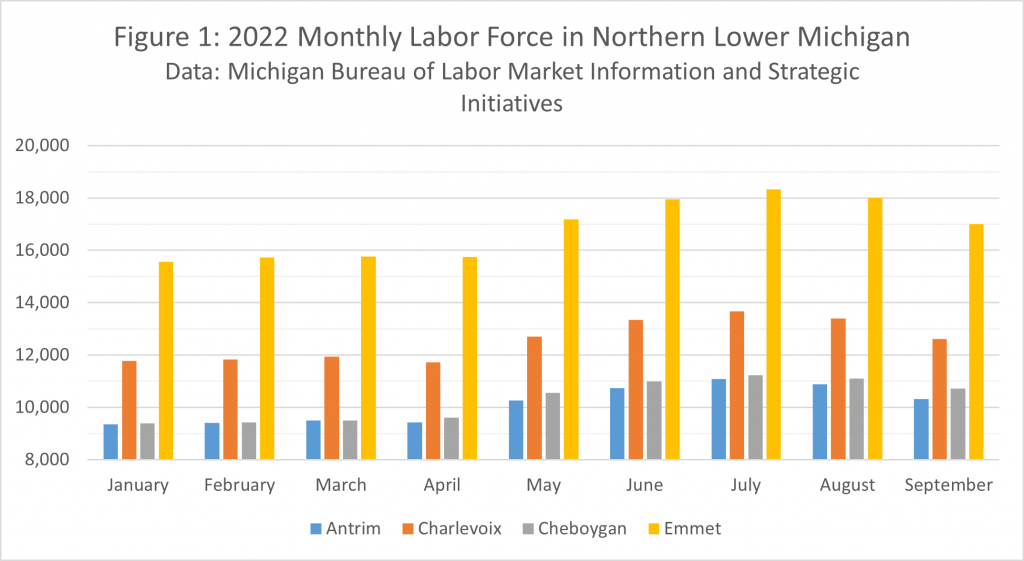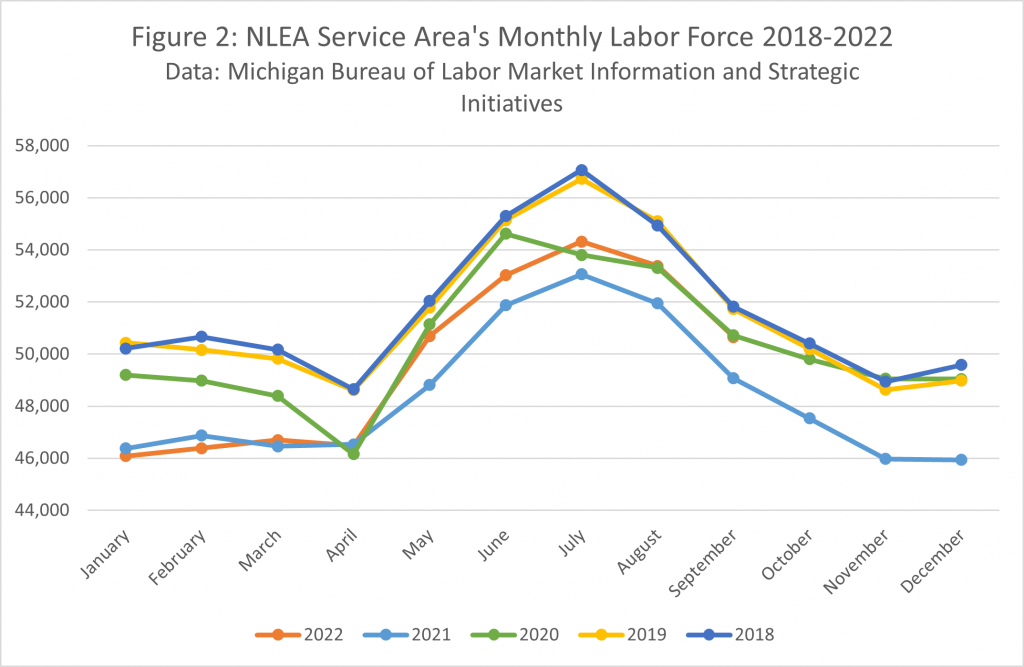This article examines the post-COVID labor force. While seasonal cycles remain, the total number of people in the workforce is smaller than before.
by Sam Bailey, Strategic Initiatives Manager
The year 2022 was supposed to be the year when things got back to normal with many business sectors returning to their pre-COVID operations. But was that the case? It depends how you define normal. In Northern Lower Michigan, businesses were open with little to no COVID restrictions, and the economy saw its traditional summer tourism season which decreased unemployment and pulled individuals into the work force. The regional labor force partially bounced back from 2021 lows, but it is still markedly lower than pre-pandemic levels and will likely remain so.
Residents of Northern Lower Michigan are familiar with the swell of economic activity that happens every summer, and this year was no different. The summer season pulled thousands of workers into the labor force and drove down the monthly unemployment rate. Table 1 reveals that seasonal unemployment fluctuations in 2022 are on par with previous years. Table 1: 2022 Monthly Unemployment Rate

Prior to the pandemic, Antrim, Charlevoix, and Emmet Counties typically fluctuated between eight and five percent unemployment while Cheboygan fluctuates between five and fifteen percent unemployment. It is important to note that many economists argue that between three and six percent unemployment to be full employment and not particularly concerning. This is because there are always some workers who may be temporarily unemployed, as they move from one job to the other or for other reasons. While this cycle is familiar to many residents, it is a key metric to advocate for a twelve-month economy in the region. To improve quality of life and create economic opportunities for locals, more must be done to stabilize the annual fluctuations in unemployment.
In 2022, the combined labor force of Antrim, Charlevoix, Cheboygan, and Emmet Counties grew from 46,085 workers in January to 54,319 workers at its peak in July. Figure 1 reveals that much of that growth was concentrated in Emmet County which added 2,773 workers
between January and July.

In that same time frame, Antrim County added 1,723; Charlevoix County added 1,905; and Cheboygan added 1,833. This growth is routine as high school and college students, local seasonal workers, and transient seasonal workers enter the labor force to meet increased demand.
While the seasonal cycles of 2022 seem to be back to normal, the total number of workers was not. Figure 2 shows the total monthly labor force of Antrim, Charlevoix, Cheboygan, and Emmet Counties from 2018 to 2022. It reveals a markedly smaller workforce during and after the pandemic than in years prior.

Between 2014 and 2019, the regional labor force would routinely rise from approximately 50,000 in January to over 56,000 in July. The light blue line representing 2021 shows an approximately 6.5% reduction in the workforce following the pandemic. While the orange line representing 2022 shows the labor force grew from 2021, it is still below pre-pandemic levels. At its peak in July, the 2022 workforce was still 2,413 workers smaller than in 2018. It is unlikely that the labor force will return to its pre-pandemic levels due to a combination of factors. The pandemic caused many people close to retirement age to retire early due to health concerns and a booming stock market. The region has an aging population which means an increasing number of people are exiting the workforce and there are fewer young people to fill seasonal roles and eventually fully enter the workforce. The local housing market poses a barrier to out-of-area workers looking to move here. Challenges accessing and affording childcare have led to many parents electing to exit the labor force or work part-time to care for their children. This combination of factors points toward a “new normal” like the region experienced this summer, with establishments competing for limited workers, reducing business hours, and struggling when students return to school. A new normal poses a threat to the continued success of local businesses in all sectors, and by extension the overall health of local communities.
Northern Lower Michigan needs to begin an earnest discussion around talent attraction and retention to address current and continued labor challenges. To kickstart this conversation, the 2023 Northern Lakes and Economic Symposium will focus on talent attraction and retention on May 22, 2023 at Boyne Mountain Resort in Boyne Falls, MI. Symposium attendees will hear from state officials and experts with a deep understanding of how to attract and retain talent. Through keynote speakers and breakout sessions, attendees will have the opportunity to examine talent challenges through global, community, industry cluster, and business lenses. Stay tuned for details.







